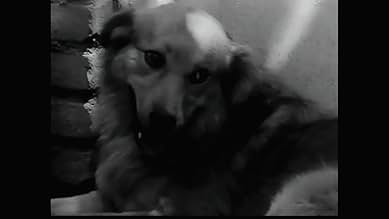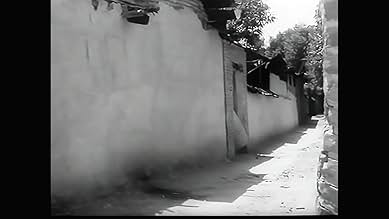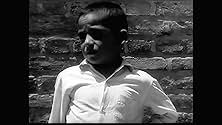Nan va Koutcheh
- 1970
- 10min
CALIFICACIÓN DE IMDb
7.0/10
1.6 k
TU CALIFICACIÓN
Agrega una trama en tu idiomaA child carrying a bread is going home but in the alley on his way to home, there is a frightening dog and he doesn't seem to pass it alone.A child carrying a bread is going home but in the alley on his way to home, there is a frightening dog and he doesn't seem to pass it alone.A child carrying a bread is going home but in the alley on his way to home, there is a frightening dog and he doesn't seem to pass it alone.
- Dirección
- Guionista
- Elenco
- Dirección
- Guionista
- Todo el elenco y el equipo
- Producción, taquilla y más en IMDbPro
Opiniones destacadas
Bread and Alley is the first film directed by veteran Iranian director Abbas Kiarostami.By making a small kid as a protagonist of this film, he has inaugurated a new trend of making films with young and non professional actors.It is because of this professional stance that we can state that Nan Va Koutcheh is a good short film not only for young children but also for adults of all age groups.It shows how some universal concepts are easily grasped by both young and old alike.The main theme of the film is a short tale about infantile fear and the extraordinary relationship which links a human being to an animal.At the core of this film is a boy who is carrying some loaves of bread for his family.The sentiment of fear has been depicted without any kind of maudlin albeit emotional theatricality as the child protagonist gives an honest as well as frank acting performance.This is the reason why the whole game of fear appears to be much too real.Scenes showing a dog interacting with a young boy are pure cinematographic joy.The background score is lovely too and provides a healthy listening opportunity to all and sundry.
Ten minutes only, and a whole bunch of universes: the universe of narrow, long, empty streets, potentially oppressive, the universe of genuine fear, the universe of feelings of the animal: hostility, joy, disappointment.
A road within a spacial context rather arid, and situations emerging suddenly and developing on their own: from this first movie Kiarostami knew that the extraordinary is hidden in the banality of everyday; he knew that an artist is an observer, capturing any situation and letting it to develop on its own. Watch this first movie ten minutes long, watch Taste of Cherry, watch Ten: the same great artistic concept.
A road within a spacial context rather arid, and situations emerging suddenly and developing on their own: from this first movie Kiarostami knew that the extraordinary is hidden in the banality of everyday; he knew that an artist is an observer, capturing any situation and letting it to develop on its own. Watch this first movie ten minutes long, watch Taste of Cherry, watch Ten: the same great artistic concept.
The 10 minute film begins with a boy returning home through empty semi-urban alleys holding bread he has purchased for the family. He is merrily kicking an empty can as boy would a football. Suddenly a growling stray dog is in his way. The boy freezes in fear. He waits for someone to give him company to negotiate the alley. An old partly deaf man comes and the boy picks up the courage to follow him. But the old man enters a door in the alley and the boy is in square one.
He decides to throw a bit of the bread to the dog and negotiate the rest of the alley. The dog is happy and escorts the boy wagging his tail. At the door of his home, the boy's mother slams the door on the face of the dog.
Cut to the next day. The boy is negotiating the same alley and the dog with a bowl of milk or buttermilk. The boy has drunk some of it as he has a milk mustache in evidence. This time the dog is angry and the bowl of milk is dropped.
Why does the dog behave this way? The slammed door? It is for the viewer's interpretation.
This short was on show in a section on Early Iranian cinema at the on-going International Film Festival of Kerala, India
Interestingly dogs in some Muslim countries are not considered clean and not encouraged as pets. I wonder what the director Abbas Kiorastami's view on dogs are.
P.S. The film is shot in color. The film is not in b/w as stated by IMDb.
He decides to throw a bit of the bread to the dog and negotiate the rest of the alley. The dog is happy and escorts the boy wagging his tail. At the door of his home, the boy's mother slams the door on the face of the dog.
Cut to the next day. The boy is negotiating the same alley and the dog with a bowl of milk or buttermilk. The boy has drunk some of it as he has a milk mustache in evidence. This time the dog is angry and the bowl of milk is dropped.
Why does the dog behave this way? The slammed door? It is for the viewer's interpretation.
This short was on show in a section on Early Iranian cinema at the on-going International Film Festival of Kerala, India
Interestingly dogs in some Muslim countries are not considered clean and not encouraged as pets. I wonder what the director Abbas Kiorastami's view on dogs are.
P.S. The film is shot in color. The film is not in b/w as stated by IMDb.
¿Sabías que…?
- TriviaAbbas Kiarostami's first short film.
- ConexionesFeatured in Chaplin Today: The Kid (2003)
Selecciones populares
Inicia sesión para calificar y agrega a la lista de videos para obtener recomendaciones personalizadas
Detalles
- Tiempo de ejecución10 minutos
- Color
- Mezcla de sonido
Contribuir a esta página
Sugiere una edición o agrega el contenido que falta

Principales brechas de datos
By what name was Nan va Koutcheh (1970) officially released in Canada in English?
Responda
















